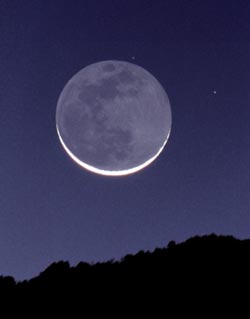
In Pearce, Arizona, Matt BenDaniel recorded the Moon at dawn on October 15, 2001, only 30.8 hours before new. He took the 4-second exposure on Kodak E200 film with a 130-millimeter Astro-Physics refractor at f/6.7.
A quaint superstition says it's good luck to see a new Moon over your left shoulder. And if you do, bow to it
three times and make a wish!
Every new Moon brings several mornings of thinning crescents in the predawn sky. Then come 30 to 40 hours of
invisibility in the Sun's glare, after which the Moon reappears in the evening twilight. This monthly drama is
unfolding right now. Photographers should be thinking ahead to the coming weekend and how they might best
frame their close-ups of the hairline lunar crescent in a foreground scene.
"Opposing Crescents"
The Moon technically reaches its new phase the moment it passes the Sun each month. That occurs at 3:13 Universal
Time on June 15, 2007, which is late Thursday evening, June 14th, in North America. Don't even bother looking
for the Moon that night — you won't see it.
But longtime moonwatcher Robert C. Victor alerts North Americans to the rare chance for a dual sighting this
month: the waning crescent in the eastern sky Thursday morning, and the waxing crescent low in the west after
sunset Friday evening. This feat (seeing morning and evening crescents on consecutive days) was considered
impossible just 20 years ago. The people who've done it can be counted on the fingers of one hand.
"With the long June days," Victor says, "and with a new Moon far north of the Sun and not long after perigee,
conditions are unusually favorable for observers in the 48 states to catch these opposing crescents." He has
provided more details in the Abrams Planetarium Sky Calendar, available by subscription from Michigan State University.
The morning crescent will be trickiest to spot west of the Rocky Mountains, where it will be just 15 hours
from new and extremely low in the northeast, 15 to 30 minutes before sunup. But Friday evening's crescent, 24
hours after new, should be fairly straightforward for diligent observers.
Those along the US Eastern Seaboard appear to have the best chance for sightings of both crescents, weather
permitting. In Florida, for example, Thursday morning's crescent is 17 hours from new Moon and 5° above
the ocean horizon at around 6:10 a.m. EDT. Friday evening's Moon is 21 hours past new and 8° up in the
west at 8:30 p.m. EDT. In both cases, look right where the twilight glow is brightest.
These sightings won't be easy. Definitely use binoculars!
 0
0
Comments
You must be logged in to post a comment.